The Angolan long-eared bat is a species of vesper bat in the Vespertilionidae family. It can be found in moist savanna in Angola and Democratic Republic of the Congo.
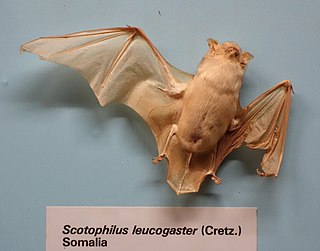
The white-bellied yellow bat or white-bellied house bat, is a species of vesper bat in the genus Scotophilus, the house bats. It can be found in Angola, Benin, Botswana, Burkina Faso, Cameroon, Central African Republic, Chad, Ivory Coast, Gambia, Ghana, Guinea, Guinea-Bissau, Kenya, Mali, Mauritania, Namibia, Niger, Nigeria, Senegal, Sierra Leone, Sudan, Togo, Uganda, and Zambia. It is found in dry and moist savanna and open woodland. It is a common species with a very wide range, and the International Union for Conservation of Nature has assessed its conservation status as being of "least concern".
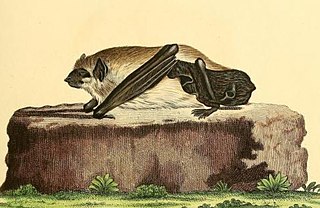
Schreber's yellow bat or the giant house bat, is a species of vesper bat. It is found in Benin, Democratic Republic of the Congo, Ivory Coast, Ghana, Kenya, Malawi, Mozambique, Nigeria, Senegal, Tanzania, Togo, and Zimbabwe. Its natural habitats are subtropical or tropical moist lowland forests, dry savanna, and moist savanna. It is an uncommon species and its biology is poorly known. It was first described in 1774 by the German naturalist Johann Christian Daniel von Schreber, who named it Vespertilio nigrita. It was later transferred to the genus Scotophilus, making it Scotophilus nigrita.
The Zulu serotine, also called the Zulu pipistrelle, aloe bat, or aloe serotine, is a species of vesper bat found in Angola, Botswana, Democratic Republic of the Congo, Ethiopia, Kenya, Malawi, Namibia, South Africa, South Sudan, Uganda, Zambia, and Zimbabwe. Its natural habitats are savanna and hot deserts.

The Angola lark or Angola bushlark is a species of lark in the family Alaudidae found in southern and central Africa.
Thomas's rope squirrel or redless tree squirrel is a species of rodent in the family Sciuridae. It is found in Benin, Cameroon, Central African Republic, Democratic Republic of the Congo, Equatorial Guinea, Gabon, and Nigeria. Its natural habitat is subtropical or tropical moist lowland forests. It is a common species and the International Union for Conservation of Nature has rated it as being of "least concern".

The Lady Burton's rope squirrel is a species of rodent in the family Sciuridae. It is found in Cameroon, Central African Republic, Republic of the Congo, Equatorial Guinea, and Gabon. Its natural habitats are tropical and subtropical moist broadleaf forests and subtropical or tropical moist montane forest. It is a common species with a wide range, and the International Union for Conservation of Nature has rated it as being of "least concern".
The Angolan African dormouse is a species of rodent in the family Gliridae. Found in central and north Angola and western Zambia, it has been recorded from seven localities over an altitudinal range from 1,000 to 2,000 m above sea level. Its natural habitat is tropical dry forests. Although the population size is unknown, it is thought to be generally uncommon.
Kellen's dormouse is a species of rodent in the family Gliridae. It is native to tropical Africa where its range extends from the Gambia and Senegal to Kenya and Tanzania. Its natural habitats are subtropical or tropical dry forests, and moist or dry savannah.

The forest giant squirrel or Stanger's squirrel is a species of rodent in the family Sciuridae found in Angola, Benin, Burundi, Cameroon, the Central African Republic, the Republic of the Congo, the Democratic Republic of the Congo, Ivory Coast, Equatorial Guinea, Gabon, Ghana, Kenya, Liberia, Nigeria, Rwanda, Sierra Leone, Tanzania, Togo, and Uganda. Its natural habitats are subtropical or tropical moist lowland forests and plantations.
Duke of Abruzzi's free-tailed bat is a species of bat in the family Molossidae. It is found in Cameroon, Central African Republic, Democratic Republic of the Congo, Ivory Coast, Gabon, Ghana, South Sudan, and Uganda. Its natural habitats are subtropical or tropical dry forest, subtropical or tropical moist lowland forest, and moist savanna. It is threatened by habitat loss.

The Peters's epauletted fruit bat is a species of megabat in the family Pteropodidae. It is found in Angola, Botswana, Democratic Republic of the Congo, Eswatini, Malawi, Mozambique, Namibia, Tanzania, Zambia, and Zimbabwe. Its natural habitat is in riverine or evergreen forest, or moist woodland, where there are fruit-bearing trees.
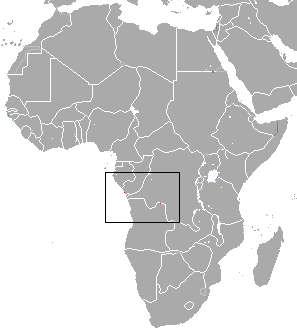
The lesser Angolan epauletted fruit bat is a species of megabat in the family Pteropodidae. It is found in Angola and the Republic of the Congo. Its natural habitats are subtropical or tropical dry and moist lowland forest, and savanna.
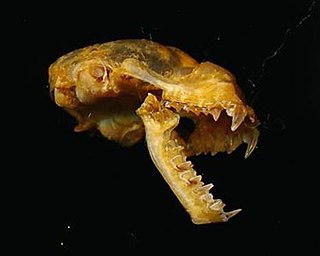
The Benito roundleaf bat is a species of bat in the family Hipposideridae found in Cameroon, Central African Republic, Republic of the Congo, Democratic Republic of the Congo, Ivory Coast, Equatorial Guinea, Gabon, Ghana, Guinea, Liberia, Nigeria, Sierra Leone, South Sudan, and Togo. Its natural habitat is subtropical or tropical moist lowland forests.

The little collared fruit bat is a species of megabat in the family Pteropodidae found in Angola, Cameroon, the Central African Republic, the Republic of the Congo, the Democratic Republic of the Congo, Ivory Coast, Equatorial Guinea, Gabon, Ghana, Guinea, Liberia, Nigeria, Rwanda, Sierra Leone, South Sudan, Togo, and Uganda. Its natural habitats are subtropical or tropical moist lowland forests and moist savanna.

The Bini free-tailed bat is a species of bat in the family Molossidae found in West and Central Africa. Its natural habitat is subtropical or tropical moist lowland forests.

The halcyon horseshoe bat is a species of bat in the family Rhinolophidae. It is found in Cameroon, Republic of the Congo, Democratic Republic of the Congo, Ivory Coast, Equatorial Guinea, Ghana, Guinea, Kenya, Liberia, Nigeria, Senegal, South Sudan, Togo, Uganda, possibly Gabon, and possibly Sierra Leone. Its natural habitats are subtropical and tropical dry and moist lowland forest, moist savanna, caves, and other subterranean habitats.

Darling's horseshoe bat is a species of bat in the family Rhinolophidae found in Africa. Its natural habitats are dry savanna, caves and other subterranean habitats.
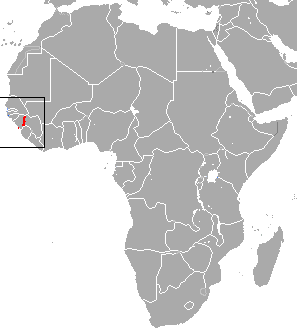
Maclaud's horseshoe bat is a species of bat in the family Rhinolophidae. It is endemic to Guinea. Its natural habitats are moist savanna, caves and other subterranean habitats. It is one of five African microbat species to be listed as endangered by the IUCN. In 2013, Bat Conservation International listed this species as one of the 35 species of its worldwide priority list of conservation. It is threatened by habitat loss.

Zenker's fruit bat or Tear-drop bat is a species of megabat in the family Pteropodidae. Its natural habitats are tropical and subtropical moist broadleaf forests and swamps.
















